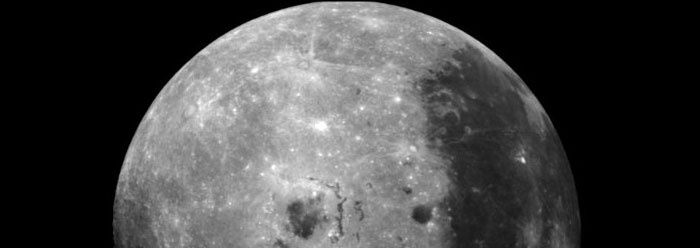 The
Moon's Latest Magnetic Mysteries by Brian Thomas, M.S. *
The
Moon's Latest Magnetic Mysteries by Brian Thomas, M.S. *
The story of the rise and fall of the moon's magnetic field constantly energizes planetary scientists. Simply put, under secular magnetism models, the moon is too small to have maintained its charge as long as evolutionists imagine and as strongly as its magnetic clues indicate. Secular scientists face a grave challenge in reconciling the moon's magnetic signatures with billion-year age assignments.
The latest foray into this collection of highly charged lunar dilemmas resulted in a team of scientists selecting a solution that, in the end, still failed to fit all the facts.
And here are a few of these relevant facts from the article, published in the Proceedings of the National Academy of Sciences (PNAS):1
- The moon has a feeble magnetic field today.
- Moon rocks retrieved by the Apollo missions contain remanent magnetism that records an ancient lunar magnetic field that was once as strong as the earth's is today.
- The most popular secular theory attempting to explain planetary magnetism involves a dynamo caused by differentially rotating molten fluids near the core. But the fact is such a dynamo would wear down millions of years before the age assignments evolutionists attach to the moon's days of high magnetic field strength.
The study authors considered three basic moon magnetizing models. First, they ruled out a "fluid dynamo" because it would have weakened far too soon.
The second model goes something like this: perhaps large impacts (think asteroids) re-energized the moon's internal fluid motions. This seems like trying to charge a weakening generator by throwing big rocks at it. But granting this model for the sake of argument, it still fails because any magnetism somehow produced by an impact would persist no longer than about 10,000 years. That's not nearly long enough to fit their long-age ideas.
The moon rocks supposedly formed millions of years apart from one another, but they harbor signatures of a consistently strong magnetic field across all that supposed time. If impacts were the cause, one would expect fluctuating remanent magnetism that waxed and waned with every major impact.
The researchers did find a better match in a third model, but in the end, it too still falls short. It adds "precession," which describes how the moon's axis of rotation might have shifted over time, to the same improbable dynamo as the first model.2
A precession-charged dynamo, though never demonstrated as a real device in nature, might in theory have generated a magnetic field lasting long enough to explain some magnetism in later-formed moon rocks. However, it would not explain the high strength of magnetism recorded in them.
In technical terms, "Nevertheless, the high paleointensities of [three moon rocks] still present a major challenge…" according to the PNAS study authors.1
This "major challenge" understates the problem, which might better be termed an impossible challenge. Neither a 2,000 nor a 3,000 foot long rope can span the mile-wide gap across the top of Grand Canyon.
Actually the billion-year age assignments are the very source of the challenge. Secular astronomers always have, and will likely continue, to attempt to resolve an impossible dilemma—generating a magnetic field that lasts for millions of years using only natural processes. Physics is clear on this issue: friction would slow down a dynamo, restricting its total potential life span to an age that, even when assisted by imaginary impacts or precessions, falls millions of years short of, or is far too weak for, secularists' billion-year age requirements.
The magnetic fields on today's moon and the stronger one on yesterday's moon clearly "look" young. By erasing imaginary billion-year time scales, all the facts align, and the secularist's "major challenge" vaporizes.
Why do moon rocks retain remanent magnetism from a time when the moon's magnetic field was as strong as the earth's? Because those rocks formed when—or relatively soon after—God created the moon with an originally strong magnetic field only thousands of years ago. Like secular attempts to construct history by ignoring the Bible's factual historical information, the moon's magnetic field has steadily shriveled to almost nothing.
References
- Sauvet, C. et al. 2013. Persistence and origin of the lunar core dynamo. Proceedings of the National Academy of Sciences. 110 (21): 8453-8458.
- Thomas, B. What Magnetized the Moon? Creation Science Update. Posted on icr.org December 8, 2011, accessed May 25, 2013.
* Mr. Thomas is Science Writer at the Institute for Creation Research.